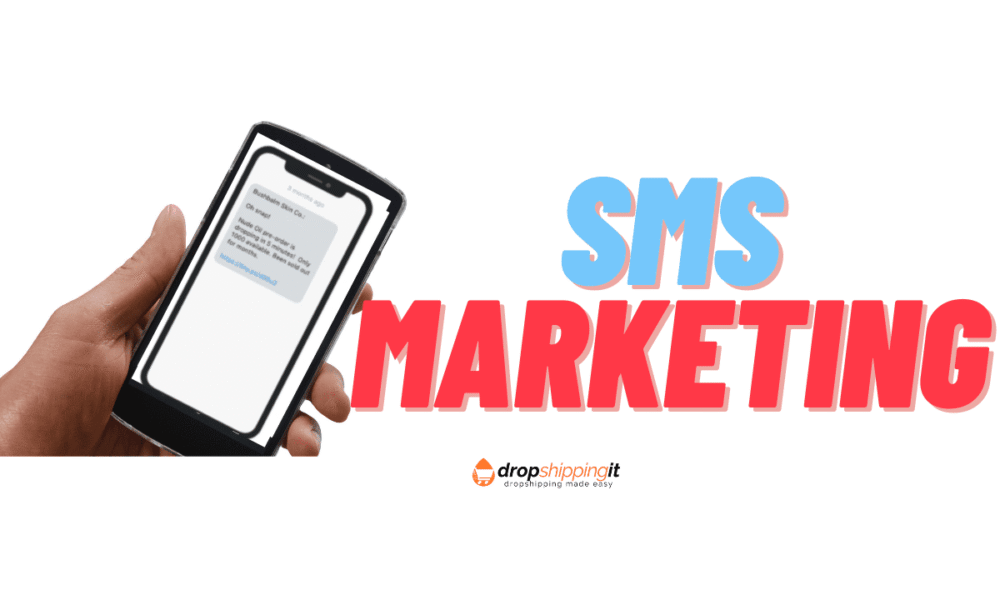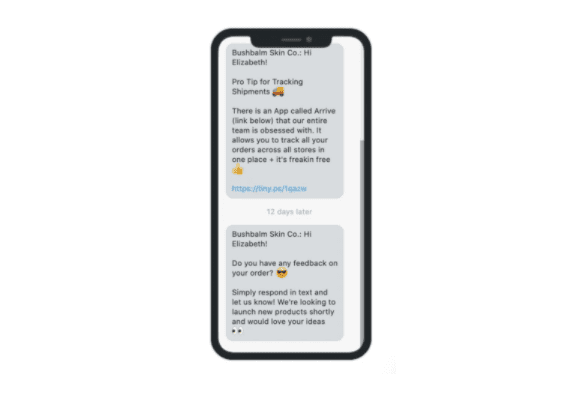If you are looking for the best Dsers Aliexpress dropshipping app alternatives,…
How To Start SMS Marketing On Shopify To Increase Conversion

Is there anything that reveals the impending holidays, like a noisy inbox? I bet nothing comes close.
“X-mass bargains start NOW!” “Check Out Black Friday bargains!”
Get 15% off this Thanksgiving!” And the alerts go on and on. Welcome to SMS marketing.
Thus, it’s presumably not unexpected that open email rates are at their lowest during the holidays—18.6%, as per Campaign Monitor—and analysts expect inboxes to get saturated in the coming days as more businesses shift online.
Data confirms that several established entrepreneurs have successfully cut through this noise with SMS marketing.
SMS marketing offers high engagement—considerably higher conversion rates—and is generally more cost-proficient.
The best part is that it’s more personal than other marketing channels and engenders more grounded customer relationships.
This blog entry promises to cover the nuts and bolts of SMS marketing, impeccable practices on this front, and models.
Table of Contents
SMS marketing: How does it Work?
Short message service marketing, or SMS marketing, essentially involves sending marketing messages to existing and potential clients via text.
The objective of SMS marketing, similar to email marketing, often revolves around selling, building loyalty, or education.

Messages can be sent as one-off campaigns, such as flash sales, or automated as a component of a drip campaign, similar to a welcome series.
SMS marketing and email are comparable, using the same modus operandi. Like email, SMS is a marketing channel owned by the sender, who controls the list of numbers and conveyance. Businesses can send one-to-many messages or one-to-one messages, contingent upon their objectives.
In SMS marketing, a shortcode is similar to an organization’s email address. A shortcode is a shortened phone number of five to six digits, abbreviated so that it’s not difficult to recall.
Buyers can text a keyword, say CRUNCHYNUTS, to the shortcode. This way, they will opt-in to receive your SMS messages. Buying into SMS messages is an intentional decision that rarely leads to fake numbers.
SMS marketing: Is it Worth Your While?
1. High engagement rates
According to data from Gartner, SMS open rates can reach as high as 98%, compared with 20% for email. More critically, SMS click-through rates can reach as high as 45%, which may stun email marketers accustomed to the 6% mean.
At this point, some brands that have employed SMS marketing for longer than a year return some exciting stats for comparison.
In automating a welcome series of messages, these businesses see over half (50%) click-through rates. Not open rates, click-through rates. In contrast, the brands usually see 25% open rates with their email marketing and just 2% click-through rates.
Short messaging service marketing appears to cure the deliverability bit because SMS marketing requires that prospects opt-in, and your list only incorporates clients who need to hear from you.
2. Easy to Write
Any individual who’s ever composed a mass email to clients appreciates how involved it can get to packing that ideal headline to get that open rate and the perfect copy that gets prospects clicking through.
SMS, however, you compose a line or two. Moreover, you don’t have to worry about design—an emoticon or GIF goes a long way; it is all required to make your message pop.

2. Foster Customer Relationships
Most importantly, you’ll discover that SMS enables you to build more personal, loyal relationships with your clients. Texts are typically easier to react to, thus facilitating 1:1 conversations. SMS has a mean response rate of 45%, contrasted with email at 6%.
You can set up SMS to send mass messages and directly engage with prospects in a successful and supported capacity.
SMS marketing: Challenges
1. Regulations
Several online marketers’ pervasive avoidance of SMS marketing is premised on the assumption that SMS marketing poses complex legalities. However, that’s incorrect. It’s imperative to appreciate SMS marketing as a consent-based channel, which implies that you need your prospects to acknowledge that you are sending them promotional text messages.
Here’s the deal. The opt-in messages should comply with the Telephone Consumer Protection Act (TCPA), which shields buyers from unregulated use of their data. If you leverage a Shopify app to send SMS marketing messages—the good news is that the apps are TCPA compliant.
2. A lean Subscriber List
One study indicates that 77% of buyers positively identify with businesses offering text as a correspondence channel.
Often contrasted with email, SMS marketing is ineffective due to low subscription figures and high opt-out rates. The facts confirm that you usually get fewer subscribers and conceivably more opt-outs, yet those on your list incredibly remain engaged.
The key is being insightful about how frequently you send messages and ensuring your content packs relevance.
3. Conceivably higher upfront expenses
You’ll appreciate that many people value their phone number more than their email address. Thus, it’s proper that you offer a better incentive to capture a new phone number from time to time.
At first, you can collect phone numbers in one of your campaigns without offering anything, for instance. Then, provide a 15% discount; you’ll experience a spike in daily sign-ups. Phone numbers prove costly to capture; with that, ensure there’s sufficient incentive.
Likewise, the cost of sending an SMS message will vary slightly, depending on the software you employ. SMS costs between $0.50 and $2, compared to email, which generally costs $0.15-0.35.
The challenge notwithstanding, there is a higher ROI. Your business can generally register about $1.5 EPM for your automated series and typically $.50 earnings per message (EPM)for your campaigns.
For instance, if we generate 2,000 new month sign-ups and send them 1 SMS each, you’d generally see $2,600 back in income, less the $20 cost to send 2,000 messages.
SMS marketing; Getting Started
You need to build a rundown of phone numbers with opt-ins consenting to receive promotional messages. Ordinarily, you’d capture these from both customers and prospects. You ought to make the list before you start an SMS marketing campaign.
Therefore, if you’re not generating traffic to your site, SMS probably won’t work. Investing weeks, months, or so in developing your SMS list first is best.

The peak shopping season is synonymous with low consumer attention, high email spam, and costly paid ads. SMS marketing works best during this period.
SMS remains an unsaturated channel; thus, it still successfully slices through the noise.
Regarding Shopify stores, getting started with SMS marketing is as simple as downloading a TCPA-compliant app. Though you’ll discover lots of apps in the App Store, this piece restricts itself to feature the following:
- Attentive Mobile is a perfect fit for brands with hundreds of thousands of subscribers. It has reputable brands like Sephora in its ranks and files.
- SMS Bump. If you’re looking for an excellent SMS marketing app, SMS Bump Cuts is often employed by several Shopify and Shopify Plus clients.
- Postscript. From experience, though subjective, the best integration for Shopify stores. It is simple to use and seamlessly integrates.
- ManyChat. Works best with global campaigns.
Best Practices in Principle
Simplify the Opt-in & Opt-out Process
Buyers’ trust is paramount to SMS marketing more than any other channel. In light of that, therefore, you must make it simple for customers to opt in and quit your SMS list. Indeed, you’ll probably lose subscribers, yet those who stay on your list do so because they need to see your message and not because it’s challenging to opt out.
You want to give your customers more control. To achieve this, you have them text your business first to join. Postscript is handy in this regard as it has a decent feature that allows your clients to text you to affirm their subscription.
Strive to inform, & short on promoting.
Since quitting promotional SMS messages is challenging, you must consider your prospects’ inboxes. As a dependable guideline, your messages should broadly identify with orders and status to solicit feedback. Rest assured, you’ll always find these consistently helpful. In practice, promotional messages should rarely pop up; for example, once a week, I would like to think.
Make it conversational
SMS is intrinsically conversational, meaning it naturally follows a back-and-forth exchange format, and marketing through SMS is the same. SMS is an extraordinary method for generating reviews and product feedback from prospects.
For instance, you can send a text soliciting the prospects’ assessment of your business’s future product offerings.
This kind of engagement excites your customers through your text messages. SMS can double as a push channel and a solid pull channel.
Messages for You to Try
Since we’ve covered SMS marketing principles, we’ll show you how to apply them in your business in this section. Consider the following:
1. The Back-in-Stock message
The message informs clients about a sold-out stock. It’s a gentle yet compelling approach to re-engaging past visits. Combine it with a free delivery minimum or different strategies to expand your mean order value. Transactional messages are practical and easy to automate.

2. The Hype-Up Text
Try not to launch a flash sale without hype. In terms of conversion, a text a couple of days earlier suffices the magic. Folks often like to plan their buys early. As such, it’s smart to give your lead clients a heads-up before your deal is live.

3. The Flash Sales message
I doubt there’s anyone who’d not want to receive these messages from their #1 brands. A short and snappy SMS is an incredible method for advancing one-off flash sales or major ads.

4. The Feedback Message
SMS is a superb channel that powers your brand to strike engaging discussions with your clients because of its conversational nature. For instance, when you conceptualize new product ideas, you may send an SMS to your clients, inviting their assessment.

A response means you’ll have a drawing in a 1:1 conversation. Aside from the engaging conversion, which will bring your clients into the process, the prospects are more than likely bound to purchase the product when it’s out.
Read Also:
- The Best Dropshipping Product Research Tools To Use
- The Product Research Module For Finding Dropshipping Product
- Do You Need An LLC For Shopify Ecommerce Store?
- Is Shopify Good For Blogging Like WordPress CMS?
- What Is Shopify’s Best Payment Provider?
Final Thought: The Old Reincarnated
Several online marketers steer away from SMS marketing on the assumption that it’s intrusive and costly.
Far from it. Applying the principles above means you’ll slice through the noise, raise your conversion rates, and build positive, loyal client relationships simultaneously. Learn more. Sell more!
Start Shopify For Only

Try Shopify free for 3 days, no credit card is required. By entering your email, you agree to receive marketing emails from Shopify.




Comments (0)